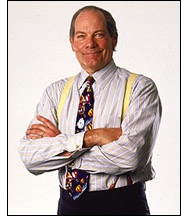
It's Memorial Day weekend and New York City is a ghost town. And that makes it a great time to stay here and enjoy

the city. Last night, a small group of stay-in-towners had dinner in the backyard cafe of
i Trulli, a tucked-away Italian restaurant on East 27th Street. (Try the risotto with shrimp, basil and crispy sage.)
The conversation turned to geniuses and I mentioned my good fortune in getting to spend 44 minutes interviewing Bill Gates in 1990, while researching a book on creativity.
So we asked everyone: "Name any genius from the beginning of time who you'd want to spend two hours with?" The answers ranged from Jesus Christ and Gautama Buddha to a Civil War amateur historian who wanted his two hours with Abe Lincoln. My choice was "Mr. Picturing Big Ideas" himself—Leonardo da Vinci.
Da Vinci was, of course, an astoundingly brilliant painter, sculptor, architect, musician, mathematician and scientist. But there were many other geniuses who excelled in those categories during the Renaissance.
What set Leonardo apart was his ability to invent things that no one else had conceived. When inventing his concepts he sketched and described them in his amazing notebooks.

For example, his pictures show a parachute that worked when tested, a defensive war machine that would push away an invader's assault ladders, an air-screw "helicopter," a projector that worked with a candle inside—and hundreds of other brainstorms, all sketched and described. Leonardo's notebooks perfectly illustrate the guiding mantra of this blog: "
If you picture it, more ideas will come."
And how would I use my two hours with Leonardo? I think I'd invite him to meet me at
i Trulli for dinner. And I'd definitely recommend that he try the risotto.
Then I'd begin by asking him how he develops his ideas? Does the picture come first—or the words? (My money is on "picture first.")

Next, I'd haul out a laptop and explain what a computer can do. He'd probably get it in 60 seconds so I'd ask: "Okay, Leonardo, what kind of uses can you think of for this thing?"
I'd explain the Internet (another 60 seconds) and ask what he'd do with it? Naturally, I'd have a notebook with me—and would sketch and describe his ideas as he created them.
Finally—lingering over our espressos—I'd tell him how many of his 400-year-old ideas were at work today: from the airplane and parachute to projectors, military tanks, and dozens more. It would be one hell of an evening!
REQUEST FOR POSTINGS: Which genius would you want to spend two hours with? Why? And what questions would you ask?










